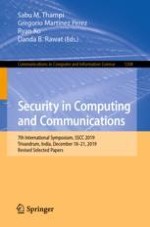2020 | OriginalPaper | Chapter
Intrusion Prediction and Detection with Deep Sequence Modeling
Authors : Gaurav Sarraf, M. S. Swetha
Published in: Security in Computing and Communications
Publisher: Springer Singapore
Activate our intelligent search to find suitable subject content or patents.
Select sections of text to find matching patents with Artificial Intelligence. powered by
Select sections of text to find additional relevant content using AI-assisted search. powered by
